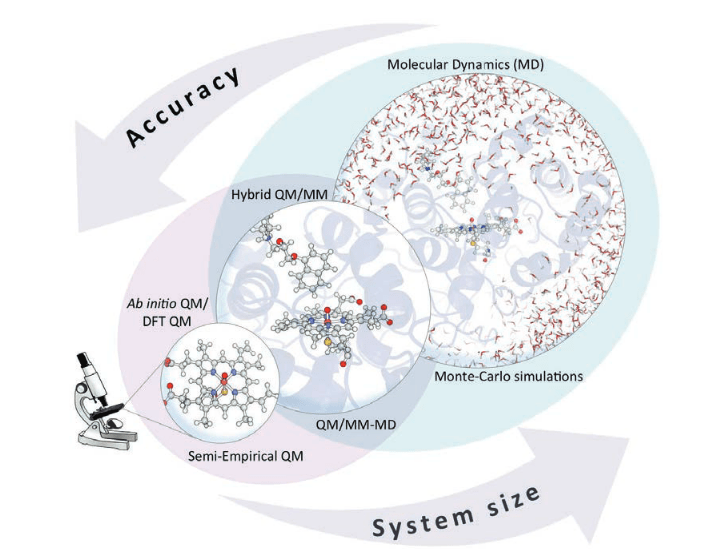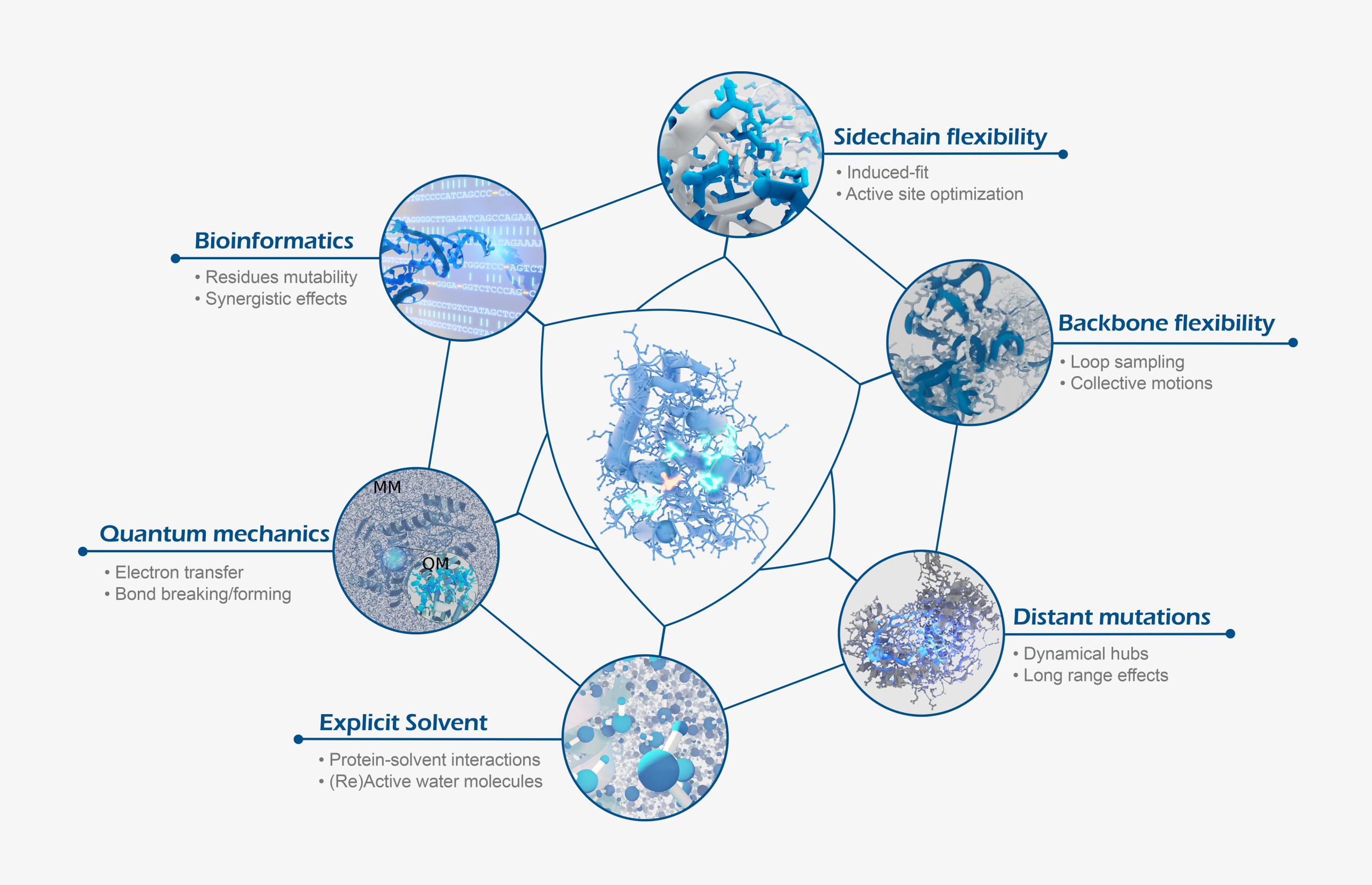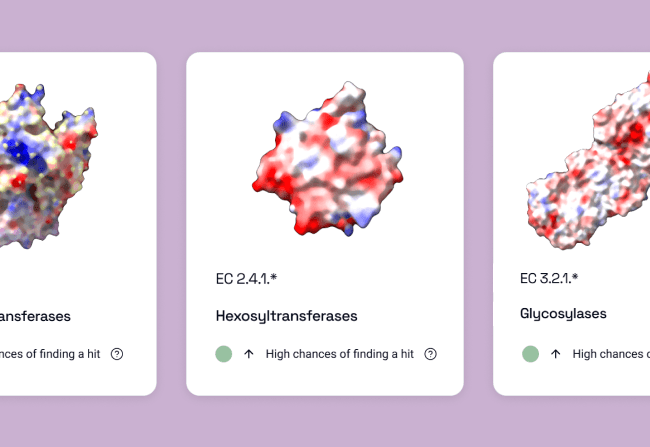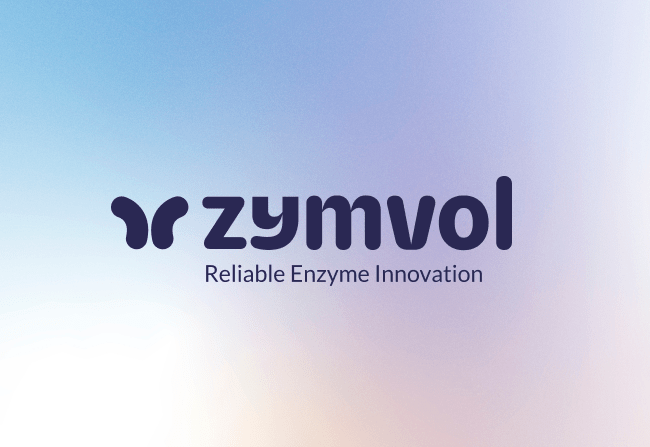September 14, 2021
A look at our Enzyme Technology: Molecular Modeling

This post has been written by ZYMVOL's Senior Researchers Marina Cañellas and Lur Alonso.
Zymvol’s core technology is Molecular Modeling, which – along with bioinformatics – allows us to understand the mechanistic details under enzymatic function and use the generated knowledge to search and tailor biocatalysts towards improved properties.
In this way, by integrating molecular modeling-based strategies at distinct levels of theory, we can identify the best target enzymes and perform their custom design in less than one month!
So, what is Molecular Modeling?
Molecular Modeling refers to a collection of in silico methods that model or mimic the behavior of molecules, ions and/or particles (Nature Subjects). Their main goal is to provide knowledge on the chemistry, structure, dynamics and function of these systems.
By definition, In silico refers to “conducted or produced by means of computer modelling or computer simulation” (Oxford Dictionary). Simply put, as these methods require huge amounts of calculations, they are performed by computers.
Molecular Modeling has a wide range of applications in many different areas: computational chemistry, computational biology, drug design, material science… and for this reason it has become a rapidly growing field during the last decades.
The large variety of systems that can be modeled range from small chemical systems (like the reaction mechanism between two substrates) to larger biological molecules (such as enzymes, antibodies or DNA) and material/molecular assemblies (like supramolecular polymers (Bochiccio, 2017; Frederix, 2018), protein-based assemblies (Soni, 2017), and molecular machines (Aprahamian, 2020).
Although many limitations still exist, they have shed light on some features like functions, processes, and catalytic pathways.
QM and MM
Because of the high complexity underneath molecular systems, such as enzyme-catalyzed reactions, there is not a single in silico technique that suffices for their full modeling. In this way, two main categories of computational methods have been developed at different levels of description:
-
- Those describing systems from an electronic point of view (Quantum Mechanics (QM) methods, this is the deepest level of accuracy to study a system!)
- Those that describe systems at the atomic level (Molecular Mechanics (MM) methods).
QM methods provide an accurate representation of the system, enabling the description of reaction mechanisms at the electron level, but are computationally very expensive.
On the other hand, MM methods allow the study of larger molecules like proteins, enabling sampling the overall system flexibility, but cannot represent bond-breaking/bond-forming events. As a solution to this issue, the benefits of both strategies can synergize into hybrid schemes, such as combined Quantum Mechanics/Molecular Mechanics methods (QM/MM), enabling the accurate description of large biological phenomena and reactions. QM/MM was awarded with the Nobel Prize in 2013 to scientists Karplus, Levitt, and Warshel.

Adapted from Dr. Marina Cañellas PhD thesis “In silico molecular modelling and design of heme-containing peroxidases for industrial applications” 2018.
The benefits of Molecular Modeling
Why do we think that relying only on bioinformatics is not enough?
Of course, there are some perks to it.
-
- Allows to simulate an entire chemical system in the computer
- It has unique potential to offer detailed atomic-level insights into the studied systems
- Allows to predict new mutant variants beyond currently available data.
- Allows to perform millions of screening/mutations in one day, saving up to 90% of time (compared to experimental procedure).
- Saves resources since only a low number of enzymes are tested in the lab (maximum of 300 enzymes tested in the lab with Zymvol’s technology instead of up to millions using exclusively experimental approaches).
As pointed out before, Molecular Modeling techniques are always complemented with sequence-based strategies; the increasing field of bioinformatics complements the predictions and adds new hints hidden on the protein sequence!
Bioinformatics evaluates the vast amount of data collected daily worldwide and extracts extremely valuable information by applying the proper tools and algorithms.
Molecular modeling complements wet lab experiments. The way of maximizing success and development in our services Enzyme Search and In silico design is through the close collaboration between dry and wet lab. Considering these two areas as iterative approaches allows scientists to gather a deeper and faster understanding of, in this case, biocatalysis. While computational predictions need to be validated by experimental techniques, wet lab experiments can also benefit from computational approaches by reducing the research time and costs and giving valuable atomic-level insights. In this way, by analyzing huge datasets (sequences, mutant libraries, enzymatic properties, …), lab work is significantly reduced. This enables scientists to obtain results in shorter times and accelerates research/industrial projects, which is of imperious importance for the Industrial Sector (Truppo 2017).
Molecular Modeling in use
Due to the exponential increase that computational resources and strategies have undergone in the last decade, in silico simulations have gained a spot guiding the experimental work in a wide range of areas. (Check the following references for more information on these topics: Hollingsworth & Dror, 2018, Schwaigerlehner et al., 2018, Blog article Ebejer and Baron 2020, as well as more trend research like the one related to COVID19 (Talk by Strauch, 2021)).
Some fields that are benefited by these in silico methodologies include:
-
- Drug discovery (disease mechanisms)
- Neuroscience (for example, protein-protein interactions)
- Advanced therapies (for example, antibody engineering)
- Biocatalysis (for example, directed evolution)
Some practical examples:
-
- Elucidate enzymatic mechanisms, understanding enzymes’ catalytic power and enzyme design.
- Simulation of binding-free energies of small molecules (e.g drugs to their targets).
- Search for wild type enzymes to perform a particular non-natural reaction.
Getting the best out of Molecular Modeling
As it has been stated, Molecular Modeling is one of the most important approaches we use to provide our Enzyme Search and In Silico Design services. Thanks to our innovative approach, at ZYMVOL we are able to take into account the following features:
-
- Solvent effects (by incorporating explicit waters in our simulations)
- Quantic effects
- Dynamic changes of the protein backbone (backbone flexibility)
- Distant mutations
- Side chain flexibility

Normally, it's hard to find companies who work with all these features, since techniques are very expensive, time consuming or require high specialization.
The truth is that in this area, the customer moves in the trade off triangle of price-time-expertise: either techniques are very expensive (and/or time-consuming) or require scientists with outstanding degree of specialization to successfully carry out projects.
What you usually find in the market is:
-
- Companies relying only in bioinformatics and experimental work (↑time, ↑price, ↓specific expertise)
- Companies offering only experimental approach (↑time, ↑price, ↓specific expertise)
- Companies that offer excellent software, but it is very difficult to achieve quick, reliable results without the assistance of an expert. (↑time, ↓price, ↓specific expertise).
However, taking all of these features into account is truly beneficial, as it means:
-
- More realistic simulations
- More accurate results and with the unique advantage
- The possibility of obtain results in significant short times
Molecular Modeling is a truly powerful tool and it has contributed significantly to our enzyme discovery and design projects. Thanks to it, we can help many industries transition to the use of biocatalysts and make the industry greener.
References:
Aprahamian, I. (March 3, 2020) The Future of Molecular Machines. ACS Cent. Sci., 6(3), 347-359
Nature. Molecular Modelling. https://www.nature.com/subjects/molecular-modelling
You might be interested in
Start your Evolution
Create new products and processes, adapt existing ones or develop completely new biochemistry. Zymvol is here to guide you in any stage of your journey.
Go to solutions





